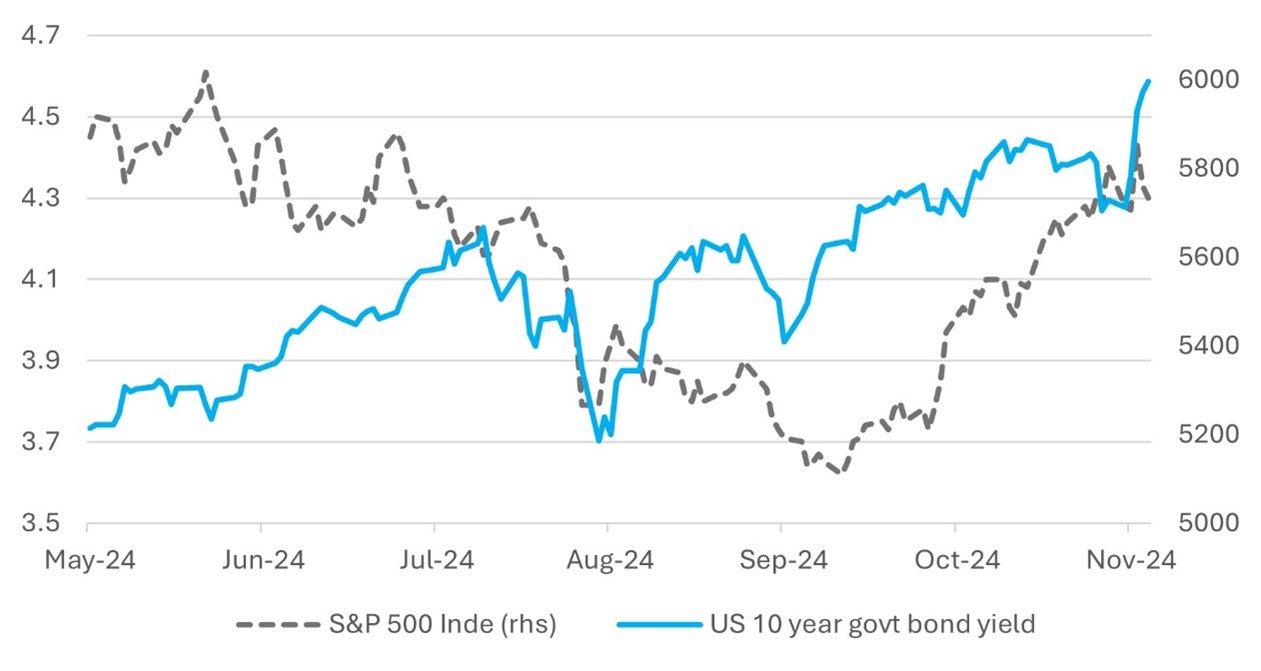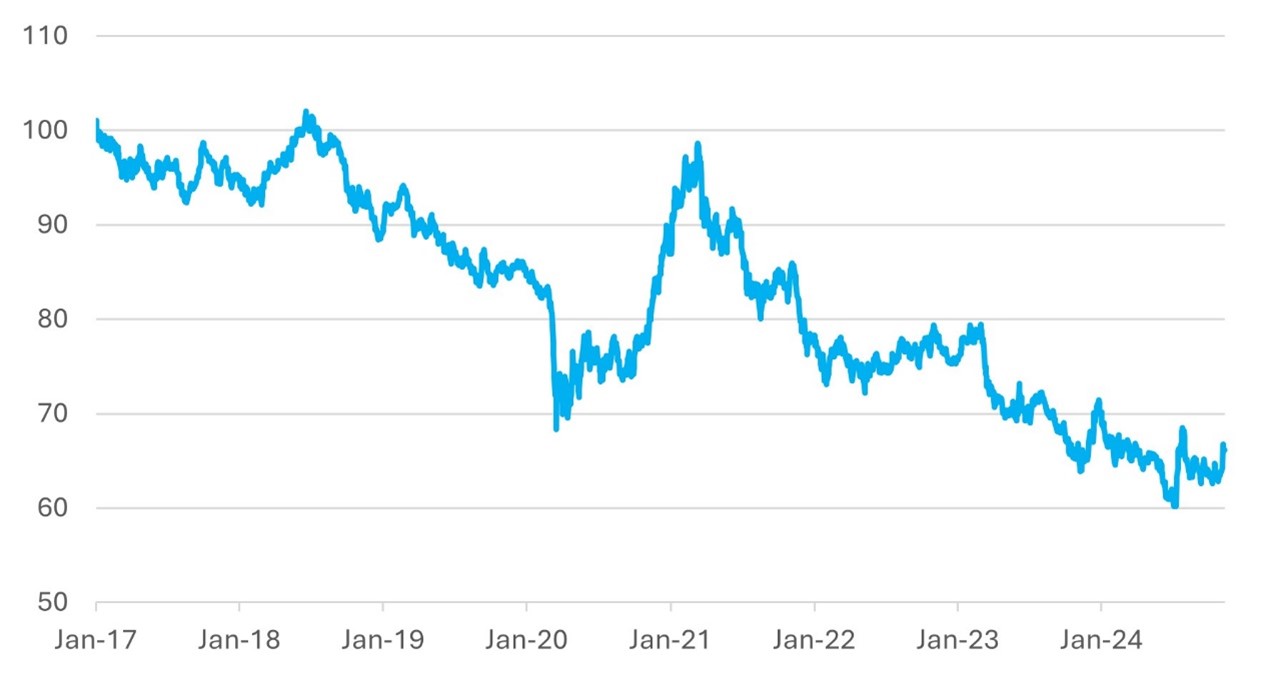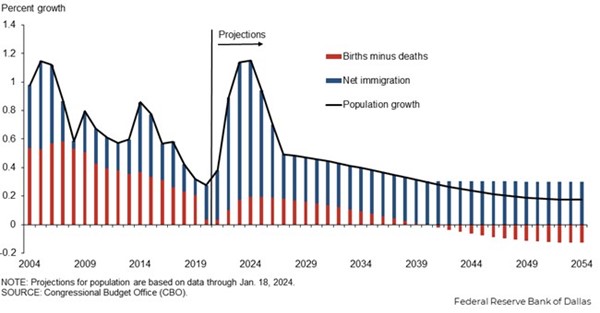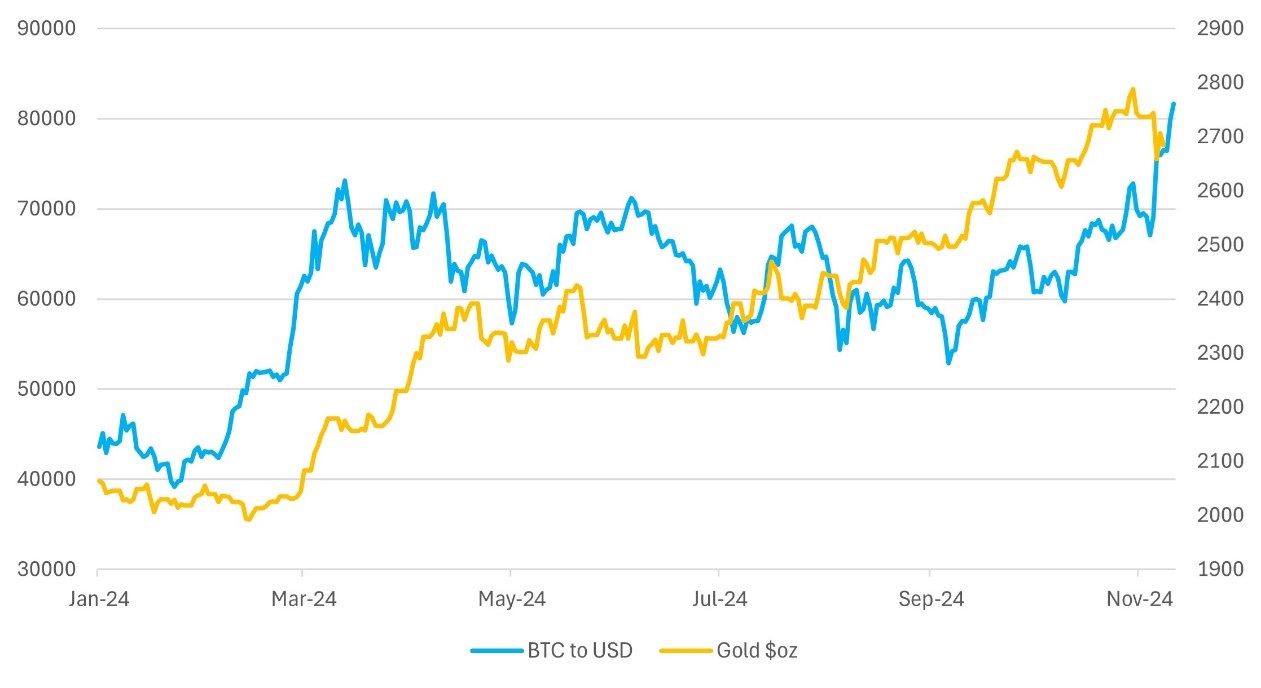By Falco
11 Nov 2024
• President-elect Donald Trump has a strong mandate to push through
• The market's initial reaction is fair with equity prices and bond yields higher
• The pace of policy changes will depend on whether the Republicans win the House
• The greater risk is to inflation - certainly if there is mass deportations, and much higher tariffs
• The dollar has rallied, but so too Bitcoin and Gold - we believe more in the latter for the long term
Geopolitics was one of the biggest risks for 2024 that we had cautioned about – and so it has played out. As global economy continues to grapple with those risks, in America the dust has finally settled on who’s going to lead the country the next four years. It’s Donald Trump again!
A second Trump presidency could bring about sweeping changes to the global economic and geopolitical landscape. Known for his distinctive approach to leadership, Donald Trump – and his administration – would likely redefine policy approaches, particularly in managing today's complex economic climate.
Realpolitik or Need of the Hour?
In foreign trade, a Trump presidency could likely mean a return to assertive tactics aimed at securing favourable trade agreements, often under the spectre of tariffs. Domestically, Trump’s proposed economic policies of tax cuts and deregulation contrast sharply with the path that Europe is currently on. While Trump would likely press for lighter regulation, reduced emphasis on climate policies, and lower taxes, European leaders are prioritising deficit reduction and debt control, even at the expense of immediate economic growth.
Internationally, Trump’s economic stance may find traction with like-minded political dispensations. In the UK, for instance, the Reform Party shares many parallels with the Republican economic philosophy and could adopt Trump-inspired policies in the future.
However, two structural challenges remain unaddressed in Trump’s potential agenda. Firstly, the US national debt continues to grow, raising concerns about long-term implications for the dollar and inflation. Secondly, the broader American public may not see a significant relief; while corporate tax cuts may fuel profitability and drive stock markets higher, they risk exacerbating inflation and deepening income inequality. If these structural issues are not addressed, income disparity could persist or even worsen under a second Trump term.
Chart 1: Equities Up, Government Bond Prices Down Source: Bloomberg
Source: Bloomberg
Market Optimism and Economic Outlook
Risk markets are inclined to price in a positive outlook under President-elect Trump, as his core election promises—tax cuts, deregulation, and immigration reforms – could boost economic confidence. While the actual impact of these policies may take time to materialize, the sentiment could drive short-term optimism. Provided bond yields remain moderate, equities have potential for strong returns, with investors willing to pay premium valuations in anticipation of increased corporate earnings.
The Trade: Focus on small-cap and domestic-oriented stocks. Potentially, there may be a rebalancing between domestic GDP-driven stocks and the technology sector.
Chart 2: Core PCE inflation Moving Closer to Fed’s Target Source: Bloomberg
Source: Bloomberg
Deregulation as a Key Catalyst
Deregulation is likely to be one of Trump’s less contested agendas. Previously, he implemented an executive order requiring the removal of two existing regulations for every new one. Similar moves are expected in the new administration, with deregulation anticipated across various sectors. The immediate surge in the banking sector stocks following the election suggests that regulatory rollbacks could enhance profitability in financial services. Environmental rollbacks, in particular, may favour the fossil fuel industry’s onshore activities.
The Trade: Financials may still have some upside potential from further deregulatory moves. Other sectors, too, could benefit from environmental regulation rollbacks, but investors should consider that companies in these areas might face challenges if institutional investors continue to adhere to strict ESG criteria when selecting securities.
Closing the Border – Hurting the Economy?
The issue of immigration is a constant and thorny topic around the globe. In the US, President-elect Trump has outlined potential plans for restrictive immigration policies, which may include mass deportations of undocumented individuals and the reversal of prior immigration reforms. Since the COVID-19 downturn, the US has experienced a notable rise in immigration; according to the Congressional Budget Office (CBO), net immigration reached 2.6 million people in 2022 and is grew to 3.3 million in both 2023 and 2024. While it remains uncertain whether these restrictive measures will be enacted amid potential legal hurdles, data highlights that immigration has played a critical role in the US economic recovery, particularly in moderating wage growth.
A recent paper by the Kansas City Federal Reserve underscored how net immigration has tempered wage growth across various sectors, including leisure and hospitality, manufacturing, and information technology. Chart 3 illustrates that immigration has been pivotal in filling vacancies, particularly in labour-intensive sectors. As a result, sectors like leisure and hospitality have experienced reduced pressure to increase wages as they have been successful in attracting workers from other industries and countries.
Chart 3: Immigration Driving Population Growth
Longer term, tighter immigration norms could hurt the US's potential GDP growth.
Economic growth is fundamentally driven by workforce expansion; with an aging population and lower birth rates, the US is increasingly dependent on immigration to sustain its labour force. The underlying growth rate of the US population has halved since 2010, with the CBO projecting that number to fall to zero by 2040. In short, immigration is essential to the US economy, as it provides the labour force the necessary impetus for advancing economic expansion.
The Trade: Substantially curtailing immigration or even deporting part of the workforce could prove problematic for potential growth and will likely push inflation higher. Hence, should President-elect Donald Trump go ahead with an effective plan to mass deport or restrict immigration, bonds with longer maturities could suffer. Mass deportations might particularly hurt the smaller companies in the leisure and consumer retailing sector, which depend on more causal labour.
Universal Tariffs
Trump has proposed significant tariff increases, including a universal tariff of 10% to 20% on all imports and a substantial 60% tariff on goods from China. These measures aim to encourage domestic manufacturing and reduce reliance on foreign goods. There is a sense that the tariffs threat is potentially more bluster or a negotiation technique than a step in reality. Indeed, in the hours after the winner of the election was announced much of the political rhetoric was conspicuously devoid of any comment on the imposition of tariffs.
Economic Impact of Tariffs
1. Consumer Prices: Higher tariffs typically lead to increased costs for imported goods, which can result in higher prices for consumers. Estimates suggest that a 20% universal tariff could cost a typical American family nearly $4,000 annually.
2. Global Trade Relations: Implementing broader tariffs could strain relationships with trading partners and potentially ignite trade wars, leading to retaliatory tariffs that could harm US exporters.
3. Domestic Industries: While some domestic industries might benefit from reduced foreign competition, others that rely on imported materials could face increased production costs, potentially leading to job losses.
The Trade: Not such good news for the equity market. A Morningstar estimate suggests that taken at face value, a 10% tariff on all imports coupled with a 60% tariff on Chinese goods could reduce S&P 500 EPS by approximately 3.2% in 2025. Additional retaliatory tariffs from trading partners could further decrease EPS by 1.5%. We need to watch the tech sector in particular as tech companies, especially those with global supply chains, could be adversely affected by tariffs on imported components. Increased costs may lead to reduced earnings and potential stock price declines.
Chart 4: Nasdaq Index Relative to S&P 500  Source: Bloomberg
Source: Bloomberg
The dollar has rallied but so too Bitcoin and Gold. We believe more in the ongoing further appreciation of cryptocurrency and gold.
The greater risk in the US is of higher inflation and more debt - these may be the defining measures of Donald Trump's future presidency.
Chart 5: Bitcoin and Gold Long Term Winners Source: Bloomberg
Source: Bloomberg
Gary Dugan - Investment Committee Member
Bill O'Neill - Non-Executive Director & Investor Committee Chairman
11th November 2024
The information contained within is for educational and informational purposes ONLY. It is not intended nor should it be considered an invitation or inducement to buy or sell a security or securities noted within nor should it be viewed as a communication intended to persuade or incite you to buy or sell security or securities noted within. Any commentary provided is the opinion of the author and should not be considered a personalised recommendation. The information contained within should not be a person's sole basis for making an investment decision. Please contact your financial professional at Falco Private Wealth before making an investment decision. Falco Private Wealth are Authorised and Regulated by the Financial Conduct Authority. Registered in England: 11073543 at Millhouse, 32-38 East Street, Rochford, Essex SS4 1DB
